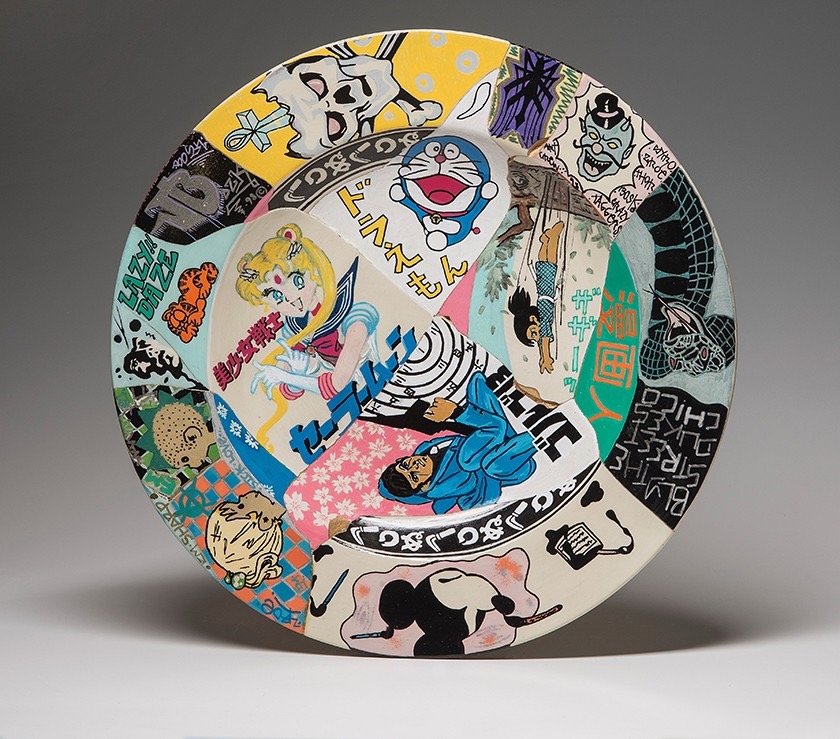Keiko Fukazawa called ceramics “soft but unyielding.” Each piece starts as soft, unformed in the potter’s hand, moist and gentle. As so often happens to human beings, too, eventually that softness hardens. In the furnace, the clay resolves into its shape, asserts itself as an object. A plate? A cup? Something entirely new? What was once earth and water becomes a thing. Yet there is still a fragility to all ceramics, by nature. One unwieldy elbow, one misplaced knee, could shatter them. An unspoken contract between viewer and art usually keeps this from happening, but each object “lives” with this risk.
Keiko Fukazawa Melds Clay’s Ancient History with Present Experiences
A career retrospective runs the risk of becoming too general, with disparate works thrown together under the umbrella of the artist’s name. Contemporary Craft, however, established greater connection between individual works by placing Fukazawa’s work in three distinct themes and periods: ARTivism, In Betweenness, and Culture Clash.
A mixture of inner exploration, social commentary, and technical play appears in the retrospective. It’s always refreshing to be reminded that an artist’s work need not look exactly the same throughout their career. Fukazawa’s practice is wide-reaching, location-wise and thematically. She both attended a Jingdezhen porcelain residency and taught incarcerated youth in the California Department of Corrections system. The retrospective includes work from both periods.
Some of Fukazawa’s most poignant sculptures come from her work as an activist against gun violence. While looking at Fukazawa’a Gun Seizure (2024), a pile of porcelain guns wrapped in steel wire, I felt a pang of emotion about how very violent and sad human life can be.
One of the exhibition’s most powerful pieces is Peacemaker 1202201514 (San Bernardino, CA) (2017), pictured in the cover image. A white porcelain gun covered with flowers sits in a deep blue brocade box. It seems delicate and fragile, with pure, white porcelain and blossoms transforming it from a gun to an ethereal form. Something about this piece made me hear Tori Amos’s “Me and a Gun,” a haunting isolated vocal describing a harrowing act of violence and violation.
Graffiti, Symbols, and Language
Much of her “ARTivism” work is in collaboration with her partner, Dennis Olanzo Callwood, and draws from graffiti. Shoot for Tomorrow (2000), recalls Roberto Lugo’s blend of graffiti and ceramics. Fukazawa uses tags to toy with the interplay between language as visual and language as a means for literal communication. In Japanese lettering, language is both, and graffiti is the space where an “a” becomes not just a typographic symbol but an image. The In-Betweenness section of the show contains work that further plays with symbols of Japanese identity and fusions of popular culture like Sailor Moon and ritual sculptures like the Maneki Neko (lucky cat).
In one photo with a graffiti frame, In Memory of Jasmine (Dennis Olanzo Callwood) (1993), Fukazawa’s ceramics frame Callwood’s photograph of a man with a tattoo reading In Memory of Jasmine on his chest. The body becomes a gravestone, surrounded by depictions of real gravestones in Fukazawa’s illustration.
It’s a powerful meditation on how images and language can serve as memorial. As a combination of the written word and emotive visuals, graffiti itself can serve as a memorial. If you’ve ever seen the tag SAPPHO around Pittsburgh, it references a deceased writer and graffiti maker. The tag will be either a relic of her tagging days or an attempt to preserve her legacy. Danny Devine, another deceased graffiti writer, has a memorial wall in Garfield on the side of Trace Brewing. Likewise, Danny Montana, a.k.a MFONE, died of a drug overdose. When his tags appear on walls across Pittsburgh, other writers know not to “buff” over them as they are made in memoriam.
To those on the outside, graffiti is low culture or vandalism. A full-chest memorial tattoo like Callwood’s might be met with a judgment of “trashiness” or similar low culture. With these works, Fukazawa and Callwood aimed to challenge assumptions about “juvie kids” and their lives and experiences. What makes these expressions of grief or anguish any different from others?
Ceramics That’s Never Stagnant
The Culture Clash segment of the show displays Fukazawa’s feeling of not-quite-belonging to Asia or America eventually was something she was able to synthesize in her work, if not totally resolve. Her Scholar’s Rock sculptures comment on Chinese capitalism and human rights abuses in combination with images of the nature-focused, “ancient” China westerners often picture. East Asian ceramics often face an exoticization, a sense that they are only ritual objects from the past, not made by living contemporary artists with complex lives and practices. Both Fukuzawa and younger artists like Adam Chau or Amia Yokoyama find a way to balance the historical importance of clay in East Asian cultures with inventive, contemporary themes and images.

Fukazawa achieves what is often so difficult to do: making work that is powerful and moving in its subject matter, technically sound, and aesthetically beautiful. Every time I look at ceramics, I feel an awareness of life’s fragility. Art’s call to us is to live anyway, love anyway, even in the face of unspeakable violence. Respond, in some way. Do not let the despair die inside of you. Fukazawa’s work is evidence of a life well-lived that never leans too much into nostalgia towards the past. It’s clear her work is always responding to the present, and that a celebratory retrospective is by no means a mark of a career’s end. Fukazawa still makes work, and the world will be all the better for it.
Story by Emma Riva
All photos courtesy of Contemporary Craft
Subscribe to TABLE Magazine’s print edition.
